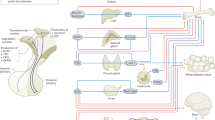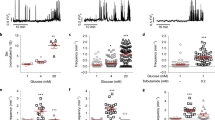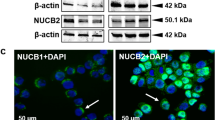Abstract
THE anterior lobe of the pituitary gland has a uniquely important function in the endocrine system, for its six different endocrine cell types constitute the major endocrine link between the brain and the rest of the body. The brain is known to control this remarkable composite gland through specialised neurones lodged in the hypothalamus that elaborate and release hypophysiotrophic factors; these are carried by the hypophysial portal blood vessels to act on their respective target cells through stimulation or inhibition of secretory activity1,2. However, the way in which these factors act at the cellular level is uncertain, although discharge of the various hormones of the anterior pituitary lobe is known to show calcium dependence and can be induced by depolarising concentrations of potassium3–5; this pattern of endocrine behaviour was first recognised in adrenal chromaffin cells6 and is consistent with the calcium hypothesis of stimulus–secretion coupling7, which, in chromaffin and some other cells, is associated with electrical excitability8–13. It is therefore of much interest that normal gland cells of the anterior pituitary lobe14,15, like their neoplastic counterparts16–18, have been found to generate action potentials with a calcium component indicative of influx of calcium ions; furthermore, the frequency of action potentials can be increased in some of these cells by thyrotropin releasing factor (TRF)14. This has prompted the suggestion that it may be through the initiation or modulation of action potentials that the brain, through the hypophysiotrophic factors, regulates secretion in the anterior pituitary14. However, the evidence which supports this scheme is scanty. The experiments with TRF were carried out on disaggregated anterior pituitary lobes of rats which contain six different endocrine cells, and the method did not allow identification of the cells stimulated by TRF; thus, it could only be supposed that they were the appropriate target cells14. Clearly, it is essential that evidence be obtained on the electrical behaviour of normal anterior lobe cells of defined type, and the effects thereon of specific and relevant hypophysiotrophic factors. Here we report that normal prolactin cells generate spontaneous action potentials which are suppressed by hypothalmic catecholamines known to inhibit prolactin secretion.
This is a preview of subscription content, access via your institution
Access options
Subscribe to this journal
Receive 51 print issues and online access
$199.00 per year
only $3.90 per issue
Buy this article
- Purchase on Springer Link
- Instant access to full article PDF
Prices may be subject to local taxes which are calculated during checkout
Similar content being viewed by others
References
Harris, G. W. J. Endocr. 53, ii–xxiii (1972).
Reichlin, S., Baldessarini, R. J. & Martin, J. B. (eds) The Hypothalamus, Vol. 56 (New York: Raven 1978).
Vale, W., Rivier, G. & Brown, M. A. Rev. Physiol. 39, 473–527 (1977).
Wakabayashi, K., Date, Y. & Tamaoki, B. Endocrinology 92, 698–704 (1973).
Nakano, H., Fawcett, C. P. & McCann, S. M. Endocrinology 98, 278–288 (1976).
Douglas, W. W. & Rubin, R. P. J. Physiol., Lond. 159, 40–57 (1961).
Douglas, W. W. Br. J. Pharmac. 34, 451–474 (1968); Ciba-Symposium 54, 61–87 (1978).
Biales, B., Dichter, M. & Tischler, A. J. Physiol., Lond. 262, 743–753 (1976).
Brandt, B. L., Hagiwara, S., Kidokoro, Y. & Miyazaki, S. J. Physiol., Lond. 263, 417–439 (1976).
Katz, B. The Release of Neural Transmitter Substances (Thomas, Springfield, 1969).
Dean, P. M. & Matthews, E. K. J. Physiol., Lond. 210, 255–264 (1970).
Meissner, H. P. & Schmelz, H. Pflugers Arch. ges. Physiol. 351, 195–206 (1974).
Douglas, W. W. Handbook of Physiology Vol. 4 (eds Greep, R. O. & Astwood, E. B.) 191–224 (1974).
Taraskevich, P. S. & Douglas, W. W. Proc. natn. Acad. Sci. U.S.A. 74, 4064–4067 (1977).
Ozawa, S. & Sand, O. Acta physiol. scand. 102, 330–341 (1978).
Kidokoro, Y. Nature 258, 741–742 (1975).
Biales, B., Dichter, M. A. & Tischler, A. Nature 267, 172–174 (1977).
Douglas, W. W. & Taraskevich, P. S. J. Physiol., Lond. 272, 41–43P (1977).
Sage, M. & Bern, H. A. Int. Rev. Cytol. 31, 339–376 (1971).
Schreibman, M. P., Leatherland, J. F. & McKeown, B. A. Am. Zool. 13, 719–742, (1973).
Holmes, R. L. & Ball, J. N. The Pituitary Gland. A Comparative Account, 170–220 (Cambridge University Press, 1974).
McKeown, B. A. Experientia 28, 675–676 (1972).
Båge, G., Ekengren, B., Fernholm, B. & Fridberg, G. Acta zool. 55, 25–45 (1974).
Zambrano, D., Clarke, W. C., Hawkins, E. F., Sage, M. & Bern, H. A. Neuroendocrinology 13, 284–298 (1974).
Nagahama, Y., Nishioka, R. S., Bern, H. A. & Gunther, R. L. Gen. comp. Endocr. 25, 166–188 (1975).
Olivereau, M. Gen. comp. Endocr. 26, 550–561 (1975).
Peter, R. E., McKeown, B. A. Gen. comp. Endocr. 25, 153–165 (1975).
Zambrano, D. Cell Tissue Res. 61, 551–563 (1975).
Wigham, T., Ball, J. N. & Ingleton, P. M. J. comp. Physiol. B104, 87–96 (1975).
Wigham, T., & Ball, J. N. J. comp. Physiol. B 110, 135–143 (1976).
Wigham, T., Nishioka, R. S. & Bern, H. A. Gen. comp. Endocr. 32, 120–131 (1977).
Olivereau, M. Cell Tissue Res. 189, 219–230 (1978).
Cook, H., Rusthoven, J. J. & Vogelzang, N. H. Z. Zellforsch. mikrosk. Anat. 414, 145–159 (1973).
Narahashi, T. Physiol. Rev. 54, 812–889 (1974).
Katz, B. & Miledi, R. J. Physiol., Lond. 203, 459–487 (1969).
Hagiwara, S. Adv. Biophys. 4, 71–102 (1973).
MacLeod, R. B. in Frontiers in Neuroendocrinology (eds Ganong, W. F. & Martini, L.) 169–194 (Raven, New York, 1976).
Schally, A. V. et al. Acta endocr., Copnh. 82, 1–14 (1976).
Juorio, A. V. J. Neurochem. 20, 641–645 (1973).
Rubin, R. Calcium and the Secretory Process (Plenum, New York, 1974).
Author information
Authors and Affiliations
Rights and permissions
About this article
Cite this article
TARASKEVICH, P., DOUGLAS, W. Catecholamines of supposed inhibitory hypophysiotrophic function suppress action potentials in prolactin cells. Nature 276, 832–834 (1978). https://doi.org/10.1038/276832a0
Received:
Accepted:
Published:
Issue Date:
DOI: https://doi.org/10.1038/276832a0
This article is cited by
-
The tilapia prolactin cell: A model for stimulus-secretion coupling
Fish Physiology and Biochemistry (1989)
-
Catecholaminotropic effects of catecholamines in a teleost fish,Anguilla rostrata
Journal of Comparative Physiology B (1985)
-
Optical recording of action potentials from vertebrate nerve terminals using potentiometric probes provides evidence for sodium and calcium components
Nature (1983)
Comments
By submitting a comment you agree to abide by our Terms and Community Guidelines. If you find something abusive or that does not comply with our terms or guidelines please flag it as inappropriate.



